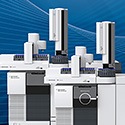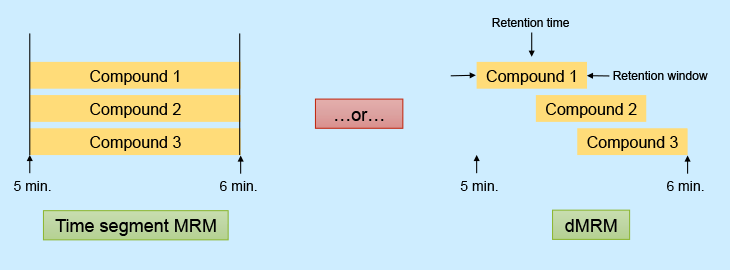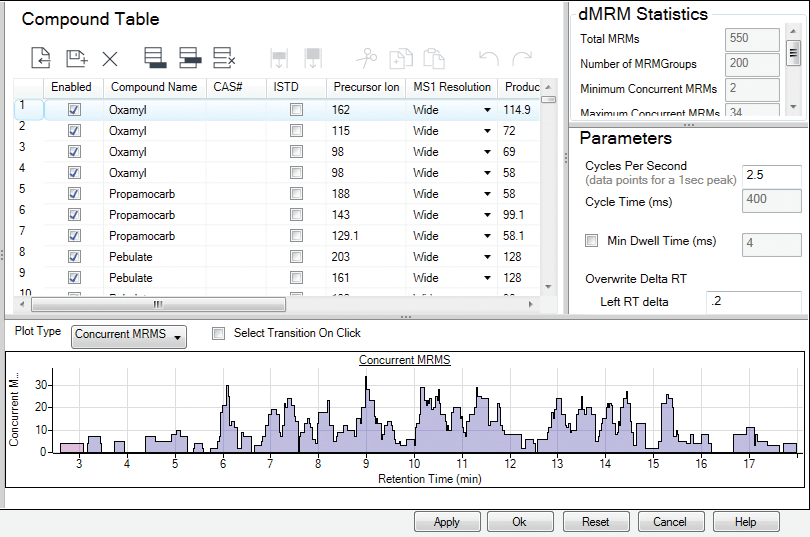Access Agilent eNewsletter November 2016

Agilent 7010B and 7000D QQQ GC/MS systems expand your lab in multiple dimensions
Thomas Doherty, Agilent GC/Triple Quad Product Manager
Triple quadrupole mass spectrometry is an ideal technique for targeted quantitative analysis, but many users are challenged to achieve higher levels of efficiency and productivity. The Agilent 7000D and 7010B Triple Quadrupole GC/MS systems are built on a proven platform—designed to help your lab increase output. These workhorse instruments now offer dynamic multiple reaction monitoring (dMRM), which simplifies method development and maintenance and improves performance. And to more easily distribute peak workloads, you can now load and execute Agilent single quad GC/MS methods on your Agilent triple quad GC/MS system.

Figure 1. Dynamic MRM uses shorter time windows, so you analyze more compounds without loss of sensitivity. Use Agilent RTL to ensure stable retention times within those windows.

Figure 2. Plot of concurrent MRMs allows you to easily visualize the high points so you can then decrease retention time windows in congested locations.
Expand your CAPABILITY with easy, robust MS/MS
Dynamic MRM provides a more intuitive way for you to specify the characteristics of the MS part of an overall GC/MS/MS method. Figure 1 compares ion monitoring for a traditional time segment MRM method with a dMRM method. By using dMRM to adjust the windows for ion monitoring, you can:
- Create and edit methods more easily—no need to constantly change time segment boundaries
- Obtain greater measurement efficiency—measure fewer compounds simultaneously; dwell times automatically increase whenever possible
- Continue to use existing time-segment-based methods, or convert them to dMRM at your own pace
Figure 2 shows an example of a pesticide analysis that will take advantage of dMRM. The high points in the plot of concurrent MRMs make it easy to identify highly congested portions of the analysis where you simultaneously monitor a large number of ions. For these locations, you can decrease retention time windows so you monitor fewer ions per unit time. Agilent Retention Time Locking (RTL) ensures that retention times remain constant within narrow time windows, so you still detect all the necessary compounds.
Dynamic MRM makes it easy to modify methods. It enables larger target lists in a single run for more efficient use of instrument time.
- Convert time-segment-based methods to dMRM methods for easier method maintenance and better performance.
- Use with the Agilent Pesticides and Environmental Pollutants Database or create your own database
- Achieve faster maximum scan speeds in combined scan/MRM mode for simultaneous analysis of nontarget ions
Choose the level of MS/MS sensitivity you need
For ultimate performance, Agilent offers the 7010B with High Efficiency Source (HES), capable of measuring down to 0.5 fg or less for octafluoronaphthalene (OFN). Or, for more routine analysis, choose the 7000D with a sensitivity of 4.0 fg or less for OFN.
Increase productivity with optional automated self-cleaning ion source
The Agilent JetClean self-cleaning ion source keeps your Agilent single or triple quadrupole GC/MS system free of matrix deposits that would otherwise build up over time and degrade instrument performance. Using a carefully controlled hydrogen flow, Agilent JetClean technology significantly reduces or even eliminates the need to clean the ion source. You achieve greater efficiency and lower cost per analysis. For more information, see the article about this exciting innovation.
Expand your CAPACITY by running SIM and scan methods on your triple quad
If you already own an Agilent 5973, 5975, or 5977 single-quad system, you can distribute your total laboratory workload to whichever instrument is available—even your 7000D or 7010B system—if it is not already busy doing MS/MS.
There is no need to run a method translation program or do manual tweaking. Just load your single-quad method and start your analysis. For selected ion monitoring (SIM) methods, the software automatically recreates the SIM table, so you measure the same compounds at the same time, with the same dwell times. Scan methods and simultaneous SIM/scan methods also transfer in an easy fashion. Only Agilent offers this level of simplicity and harmony.
Maximize lab productivity
Many labs require the selectivity of triple quadrupole MS/MS to quantify compounds in complex sample matrices. If your lab needs a triple quad that expands your CAPABILITY and CAPACITY to meet the demands of today’s workloads, explore the new Agilent 7000D and 7010B Triple Quadrupole GC/MS systems. Then contact your Agilent representative to get the most from your GC/MS investment.
Stay informed about the applications that are important to you
Subscribe to Access Agilent
Our free customized
monthly eNewsletter
Article Directory – November 2016
All articles in this issue
-
 Agilent 7010B and 7000D QQQ GC/MS systems expand your lab in multiple dimensions
Agilent 7010B and 7000D QQQ GC/MS systems expand your lab in multiple dimensions -
 Fast, accurate analysis of SVOCs with Agilent 9000 Intuvo GC
Fast, accurate analysis of SVOCs with Agilent 9000 Intuvo GC -
 Integrated workflow simplifies automated calculation of antibody-drug conjugate (ADC) drug-to-antibody ratio (DAR)
Integrated workflow simplifies automated calculation of antibody-drug conjugate (ADC) drug-to-antibody ratio (DAR) -
 Tips & tricks:
Tips & tricks:
How to simplify troubleshooting in your GC lab using Agilent ADM Flow Meter -
 Agilent collaborates with BioPharma thought leaders in India to advance biosimilar characterization
Agilent collaborates with BioPharma thought leaders in India to advance biosimilar characterization -
 Achieve fast, high throughput size exclusion chromatography of mAbs and ADCs using Agilent AdvanceBio SEC columns
Achieve fast, high throughput size exclusion chromatography of mAbs and ADCs using Agilent AdvanceBio SEC columns -
 Ask the Expert: How can I analyze virtually any polymer, from paints to polyolefins?
Ask the Expert: How can I analyze virtually any polymer, from paints to polyolefins? -
 Agilent LC/MS/MS solutions provide effective identification and quantitation of contaminants in botanical drug supplements
Agilent LC/MS/MS solutions provide effective identification and quantitation of contaminants in botanical drug supplements -
 Agilent JetClean self-cleaning ion source means you clean less, analyze more
Agilent JetClean self-cleaning ion source means you clean less, analyze more -
 High-throughput N-linked glycan profiling of monoclonal antibodies using Agilent integrated solution
High-throughput N-linked glycan profiling of monoclonal antibodies using Agilent integrated solution
Figure 1

Dynamic MRM uses shorter time windows, so you analyze more compounds without loss of sensitivity. Use Agilent RTL to ensure stable retention times within those windows.
Figure 2

Plot of concurrent MRMs allows you to easily visualize the high points so you can then decrease retention time windows in congested locations.